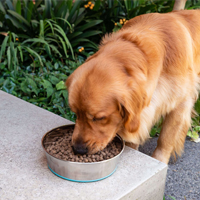
Using Echinacea for Dogs Safely
Echinacea is an herb that offers tremendous benefits for dogs. However, the key to using this herb successfully for your dog is to start it before total sickness sets in.
Echinacea contains constituents like essential oils, flavonoids, and polysaccharides, and works as an immune system supporter. For dogs, this has an interesting effect. Echinacea can lose its effect if it’s used too often, as its method of operation is contingent on essentially “fooling” the body’s system to fight a perceived immune threat.
As mentioned, echinacea dosage for dogs is most commonly referenced as an immune system booster. The herb stimulates the immune system into acting against an alleged threat, even though there is no actual threat. This causes your dog’s immune system to act accordingly, but the issue is that longevity is a factor. The body eventually catches onto the ruse, so to speak, and echinacea becomes less effective over time for your dog.
How to Use Echinacea for Dogs
- Boost Immune System: Using echinacea as an immune system booster is probably the most common purpose of this herb. Echinacea can by a tricky one because it should be ingested before your dog gets sick, which means you should use it as soon as preliminary symptoms are noted. Because echinacea charges up the system, using it when your dog is sick is futile. This herb’s key function is to build a solid foundation, not to treat a full-fledged illness.
- Increase in T-cell Production: Echinacea is often used to treat things like kennel cough and even urinary tract infections. Because echinacea increases macrophage activation, your dog will get an increase in T-cell production that is quite remarkable. This, in turn, is what delivers the immune-boosting effects of echinacea for dogs. It also kicks up chemokine production, which helps improve the migration of immune cells to the infection site.
- Regulate Carefully: Echinacea can be used by dogs that have weak immune systems, but this should be regulated carefully. Because your dog’s system will inevitably get used to the effects of echinacea, it’s best to moderate use. Some experts suggest using this herb daily for a period of about a week, then shifting to a few days off before resuming the regimen again. Results will vary for your four-legged friend, however, so you’ll want to see what works.
Echinacea Tincture Dosage for Dogs: Echinacea isn’t noted for having the best of tastes, but tincture form is recommended. This can be mixed with your pup’s food or simply syringed into your dog’s jowl. There are some prepared tinctures available at pet health food stores. The dosage will vary depending on your dog’s size, but conventional wisdom suggests about 12 to 25 drops about three times a day when signs of acute (sudden) illness present themselves. For additional help on echinacea dosage for dogs in other forms, please see our chart here.
Preventative Measures
Is echinacea safe for dogs?
As we’ve discussed, using echinacea properly is a matter of timing. This can be a delicate herbal treatment to add to your repertoire, but the immune-boosting effects really are amazing. If you can time things just right and administer echinacea to your dog at the first sign of illness or infection, you can reap the rewards of an enhanced immune system.
Some dogs have a sensitivity to some of the antigens in echinacea, so you’ll want to exercise caution. Echinacea should also not be used by dogs with compromised immune systems or other immune difficulties, as giving these systems a boost can prove troublesome.
Dogs with chronic illnesses should also avoid echinacea.
Reasons to Use Echinacea Dosage for Dogs
There are several different species of echinacea and several different products, so sorting through the details can be difficult. Always ask for help from a professional before embarking on any kind of herbal journey, even in the case of using echinacea for dogs. Echinacea may be popular for its immune-boosting effects, but that doesn’t mean there aren’t complications or that it shouldn’t be used with care.
More About Echinacea
Today we’re going to discuss the health benefits of echinacea for dogs. Most people have heard of echinacea in some way or another, with it typically associated with treating the common cold. There are a number of different species of echinacea, however, and that’s where things get tricky. Research as to the actual efficacy & health benefits of echinacea as a cold treatment is surprisingly minimal, but that doesn’t mean there aren’t effects worth noting for our purposes.
Echinacea, in fact, refers to a group of herbaceous plants in the daisy family. There are nine species in total and they are native to eastern and central North America. Known as the coneflower, echinacea is noted for several elements that many people believe contribute to immune-boosting effects. In the case of echinacea for dogs, these elements will be the focus of our conversation.
References: Herbs for Pets by M.L. Wulff-Tilford and G.L. Tilford, Natural Remedies for Dogs and Cats by CJ Puotinen










